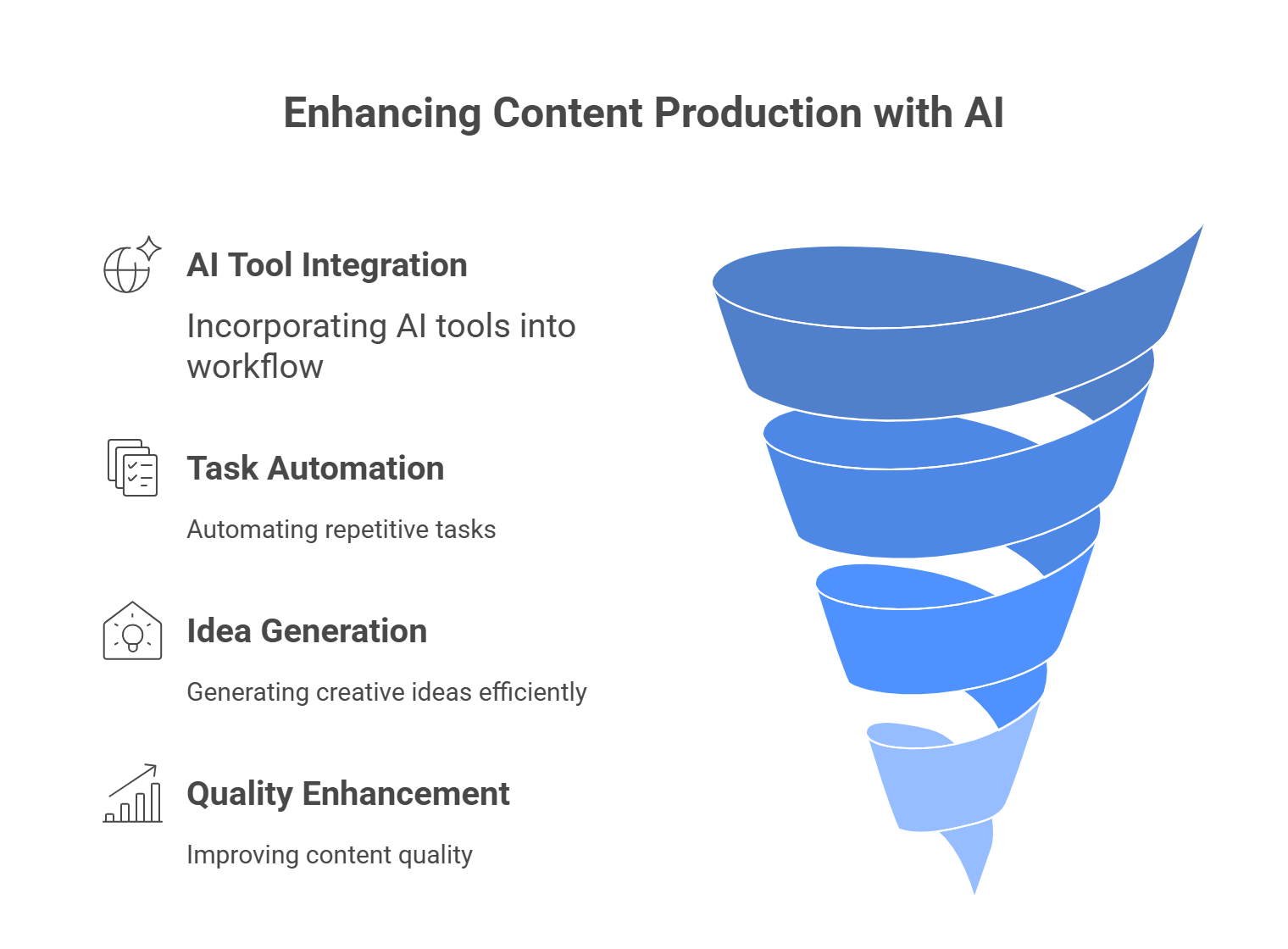Are you drowning in an endless sea of content demands? The pressure is on. You need more blog posts, more videos, more social updates—all while maintaining the high quality your audience expects. It feels like a choice between quality and quantity, a battle you can’t win. This is the Content Velocity Crisis, and it’s the bottleneck throttling your growth.
But what if you could shatter that bottleneck? What if you could increase your content production speed not by 2x or 3x, but by a staggering 10x? This isn’t a futuristic dream; it’s the reality made possible by strategically integrating Artificial Intelligence into your workflow. This guide provides a comprehensive, phase-by-phase blueprint to transform your process, shifting your role from a burnt-out creator to a strategic AI orchestrator who produces better content, faster than ever before.
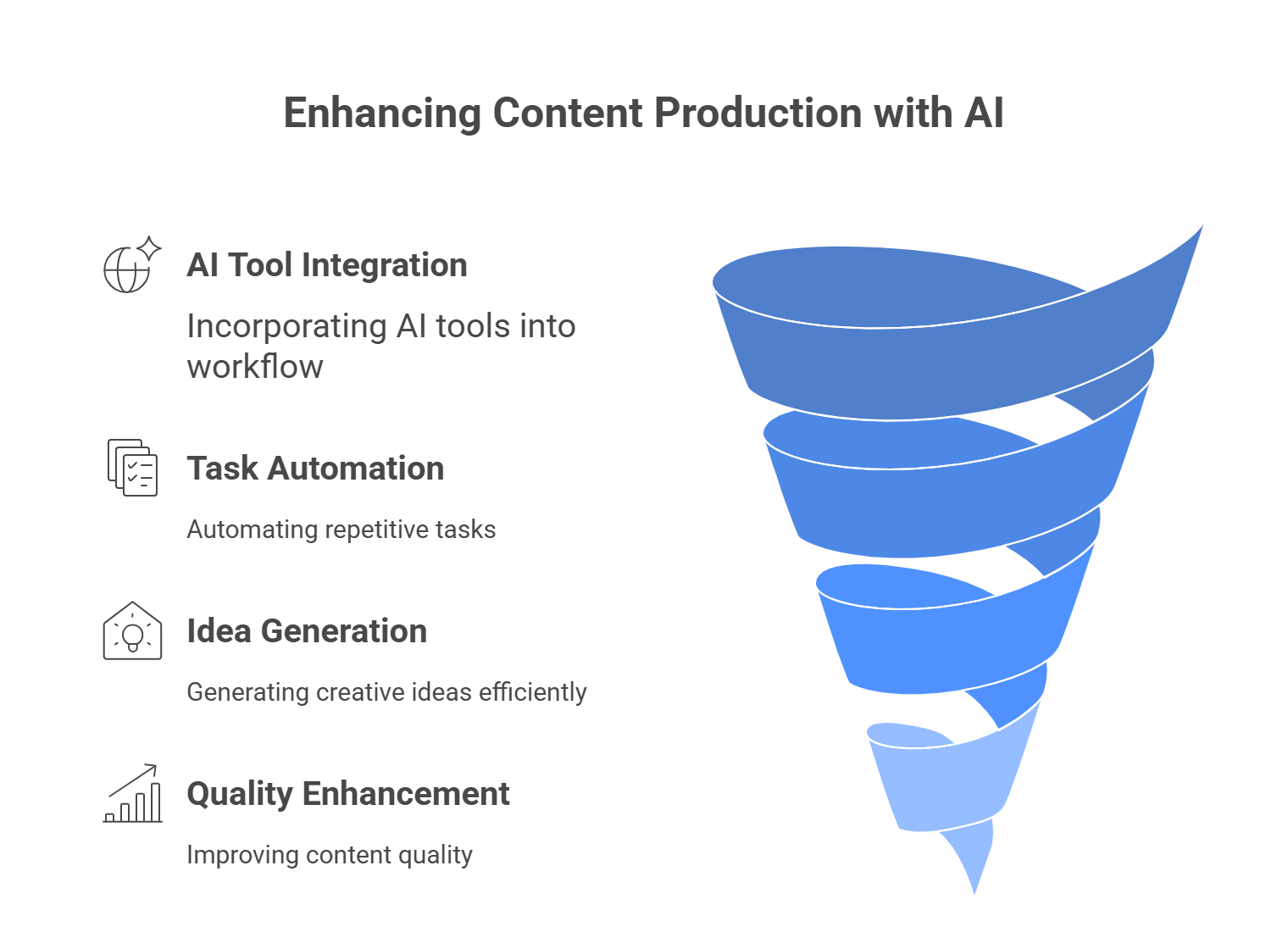
Section 1: The Content Velocity Crisis: Deconstructing the Modern Creator’s Bottlenecks
The modern content creator operates under a paradox: the demand for deeply researched, engaging content has skyrocketed, yet the resources to produce it remain scarce. To grasp the revolutionary power of AI, we must first dissect the profound time-cost of the traditional content workflow.
The Time Sink of Modern Content Creation
Creating a single, high-quality blog post is a marathon. Data reveals that the average post now takes a writer 3 hours and 51 minutes to complete—a 60% increase in time commitment compared to a decade ago. But here’s the kicker: bloggers who invest over 6 hours into a single post are the ones who consistently report “strong results.” This creates a daunting correlation: superior performance demands a time investment that most creators simply cannot afford to scale.
A breakdown of this time reveals a multi-stage gauntlet:
- Research: 2+ hours
- First Draft: 4-5 hours
- Formatting & Uploading: 1-2 hours
This crisis isn’t limited to writing. A full 69% of marketers identify the time required to produce video content as a major challenge, proving this is a cross-format phenomenon.
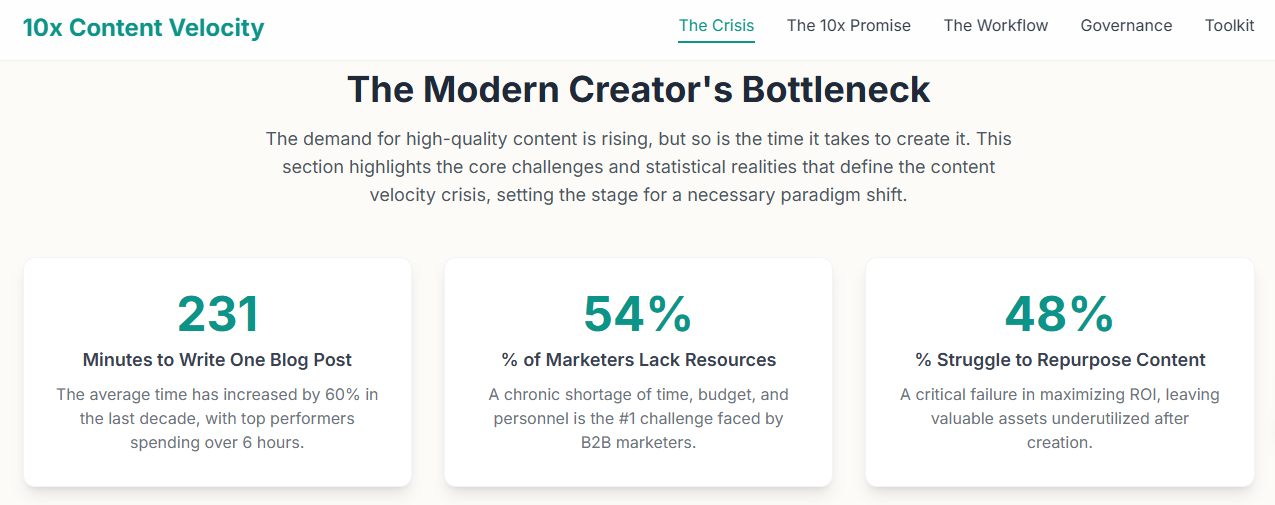
The Marketer’s Gauntlet: A Statistical Overview
Beyond the clock, strategic hurdles create a perfect storm of constraints, making the traditional workflow unsustainable.
- Resource Scarcity: A lack of resources is the top challenge for 54% of B2B marketers. This chronic shortage of time, budget, and personnel is in direct conflict with the need for more time-intensive, high-quality content.
- The Scaling Imperative: Businesses can’t afford to stand still. 48% of content marketers report that scaling content production is a persistent challenge, with 38% struggling to create more content, faster.
- The Quality vs. Quantity Dilemma: While the pressure to scale is immense, quality cannot be sacrificed. A third of marketing leaders (33%) cite creating high-quality content as one of their biggest challenges.
- Workflow Inefficiencies: Cumbersome approval processes (33%) and a failure to repurpose existing content (a struggle for 48% of B2B marketers) mean valuable assets are created at great expense and then critically underutilized.
This is a broken model. The market rewards deep, time-intensive work, while business operations demand speed and volume. This strategic impasse requires a paradigm shift. Integrating AI is no longer a “nice-to-have” efficiency tool; it is the only viable solution to build a sustainable model for content production in the modern era.
Section 2: The AI-Augmented Workflow: A New Paradigm for 10x Velocity
Achieving a tenfold increase in speed requires a radical rethinking of the entire creation process. We’re not just speeding up old tasks; we’re re-engineering the workflow itself. The AI-augmented model dismantles the linear assembly line, replacing it with a dynamic, parallel system where you become the director and AI becomes your powerhouse co-pilot.
From Linear Process to Parallel Powerhouse
The conventional workflow is a one-way street: Ideation → Research → Outline → Draft → Edit → Publish. Each step is a bottleneck waiting to happen. The AI-augmented model shatters this.
AI doesn’t just accelerate each step; it compresses and combines them. A single, well-crafted prompt can simultaneously generate topic ideas, associated keywords, competitor analysis, and a detailed, SEO-optimized outline. This single operation, executed in minutes, accomplishes what traditionally takes hours of sequential work.
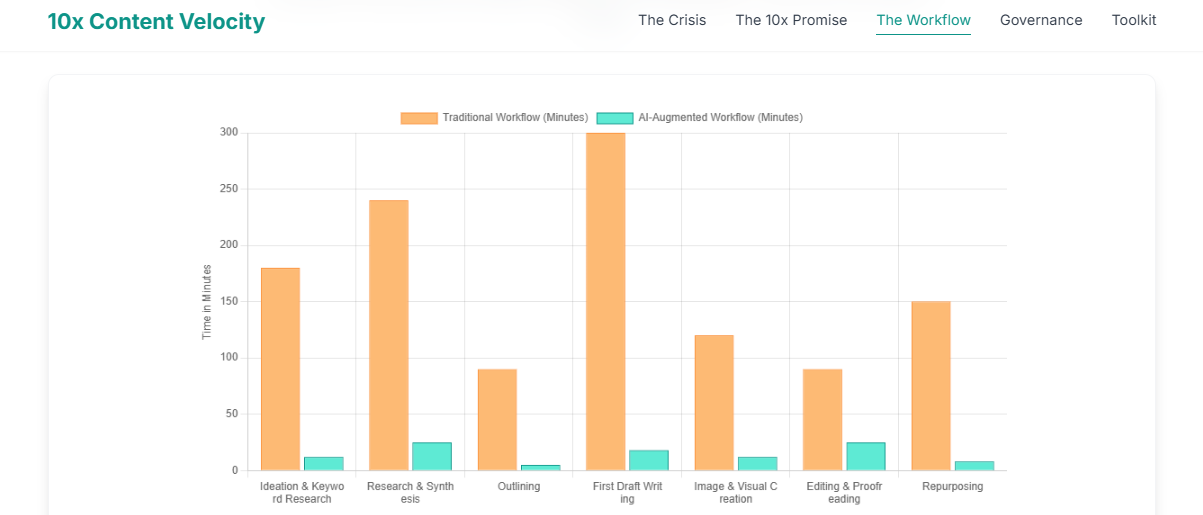
This transforms your role from a manual producer to a “Content Director” or “AI Orchestrator.” Your most valuable skills become strategic: architecting sophisticated prompts, critically evaluating AI outputs, and performing the final quality assurance that ensures brand alignment.
Quantifying the 10x Promise
A tenfold increase might sound like an exaggeration, but a quantitative analysis of a standard 2,000-word blog post reveals how it’s achieved.
Content Stage |
Traditional Workflow (Avg. Time) |
AI-Augmented Workflow (Avg. Time) |
Time Saved |
Key AI Interventions |
Ideation & Keyword Research |
2-4 hours |
10-15 minutes |
~95% |
AI idea generators, keyword clustering tools |
Research & Synthesis |
3-5 hours |
20-30 minutes |
~93% |
AI summarizers, automated data analysis |
Outlining |
1-2 hours |
5 minutes |
~95% |
AI outline generators |
First Draft Writing |
4-6 hours |
15-20 minutes |
~95% |
AI writers expanding from a detailed outline |
Image & Visual Creation |
1-3 hours |
10-15 minutes |
~90% |
AI image generators, infographic makers |
Editing & Proofreading |
1-2 hours |
20-30 minutes |
~75% |
AI grammar/style checkers, tone rewriters |
Repurposing (Social/Email) |
2-3 hours |
5-10 minutes |
~95% |
AI content repurposing tools |
Total Time |
14-25 hours |
~1.5-2 hours |
~90% |
(Approx. 10x Faster) End-to-end AI Integration |
The dramatic reduction in “First Draft Writing”—from a 6-hour marathon to a 20-minute assembly task—illustrates the core principle. You’re no longer typing 2,000 words from a blank page. You are providing a human-refined outline and instructing the AI to flesh it out. The laborious mechanics are offloaded, freeing you to focus on the high-leverage activities that truly drive performance.
Section 3: Phase 1 – Strategic Acceleration with AI-Powered Ideation and Research (Time Saved: ~95%)
The foundation of any great piece of content is laid in its initial strategic phase. Traditionally the most time-consuming part, this is where AI delivers its first and most critical velocity boost, compressing days of work into a single, highly productive session.
Hyper-Efficient Topic Brainstorming and Keyword Strategy
Struggling with fresh ideas is a common problem, but AI transforms this from a slow excavation into rapid discovery. A remarkable 71% of marketers are already using AI for content ideation.
The key is crafting detailed, context-rich prompts for tools like Gemini or Jasper AI. Don’t just ask for “blog ideas.” Instead, instruct the AI to act as a senior content strategist, providing it with your target audience personas, their pain points, and a list of topics you’ve already covered. This allows the AI to identify content gaps and generate unique, strategic ideas. This process extends seamlessly into keyword research, where AI can uncover valuable long-tail keywords and analyze search trends at a speed no human can match.
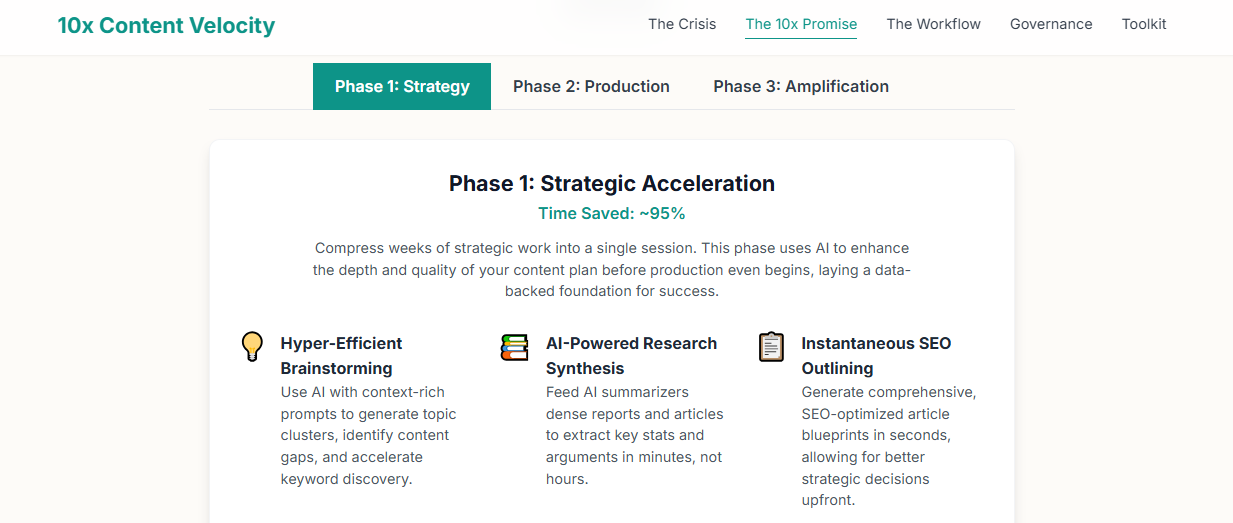
AI-Powered Research Synthesis
A comprehensive article requires synthesizing information from numerous dense reports and competitor articles—a process that can easily take 3-5 hours. AI-powered summarization tools like QuillBot are a game-changer.
Instead of spending hours reading, you can feed the URLs of relevant research into the summarizer. In seconds, it extracts the most critical statistics, arguments, and conclusions as a list of bullet points. This transforms your research from a reading marathon into a focused, 20-30 minute synthesis task, where your job is to analyze and integrate the AI-surfaced insights.
Instantaneous, SEO-Optimized Outline Generation
A well-structured outline is the blueprint for a high-quality article. AI outline generators like Surfer’s free tool can create one in seconds.
- Input your blog post title.
- Provide the primary and secondary keywords to guide the AI toward an SEO-optimized structure.
- Generate the outline. The AI will produce a complete, logical framework, including H2s, H3s, and even a potential FAQ section.
- Human Review. This final step is crucial. You refine this blueprint, injecting your unique perspective and ensuring the structure aligns perfectly with your strategic goals.
Section 4: Phase 2 – Production at Scale: From Outline to Polished Draft (Time Saved: ~90%)
With a robust strategy in place, the workflow moves to production. This is where AI assistants turn your plan into a polished piece of content at an unprecedented scale, transforming you from a writer into a director.
AI-Assisted First Drafting
The act of writing a 2,000-word article can take over six hours. AI writing assistants like Rytr or Copy.ai reduce this to minutes. The key is a controlled, section-by-section approach:
- Start with your human-refined outline from Phase 1.
- Feed the AI one section of the outline at a time (e.g., a single H2 heading and its sub-points).
- Provide specific instructions on tone, style, and key data points.
- Assemble the AI-generated sections into a cohesive first draft. This methodical process turns a six-hour writing session into a 20-minute task of assembly and prompt engineering.
The Art of AI-Powered Editing and Refinement
A raw AI draft is not a finished product. This is where you address the “generic or bland” quality that 71% of marketers worry about.
- Grammar and Style: Use tools like Grammarly or ProWritingAid for comprehensive analysis that improves clarity, conciseness, and readability.
- Tone and Voice: Combat the robotic feel with specialized tone rewriters like Wordtune. These tools can rewrite text to match your specific brand voice—be it formal, casual, or persuasive.
- Rewriting and Paraphrasing: Use AI to enhance sentence variety and strengthen vocabulary, adding a final layer of polish and originality.
Automated Visual Content Creation
Blog posts with more than 10 images report stronger results, yet creating custom visuals is a major time sink. AI visual creation tools eliminate this bottleneck.
- Blog Images: AI image generators like Junia can create high-quality featured images and in-post visuals from simple text prompts, complete with SEO-optimized alt text.
- Infographics: Turn complex data into compelling visuals. AI infographic makers like Piktochart AI can generate a professional graphic from a text prompt or document.
- Presentation Slides: Instantly repurpose your article into a presentation deck. Tools like SlidesAI.io integrate with Google Slides and PowerPoint, converting text into well-designed slides.
In this phase, your indispensable role is to apply the “authenticity layer”—the nuanced brand voice, personal anecdotes, strategic insights, and rigorous fact-checking that an AI cannot replicate. You use the time saved on manual drafting to inject the human elements that build trust and differentiate your content.
Section 5: Phase 3 – Amplification and Optimization: Maximizing Content Reach (Time Saved: ~95%)
Creating great content is only half the battle. Its value is determined by its reach. AI automates the most time-consuming amplification tasks, transforming every article into a versatile, multi-channel asset.
Intelligent Content Repurposing
A shocking 48% of B2B marketers fail to repurpose content, leaving massive value on the table. AI-powered repurposing tools eliminate this barrier.
- For WordPress Users: A plugin like All in One SEO (AIOSEO) can instantly generate FAQ blocks, key takeaway summaries, tailored social media posts for LinkedIn and X (formerly Twitter), and email newsletter copy, all from your published article.
- For Multi-Platform Use: Standalone platforms like Planable can take a blog post URL and generate multiple social media variations, complete with customized tones, lengths, hashtags, and emojis.
From Text to Video in Minutes
Video content drives huge engagement but is notoriously difficult to produce. AI-powered platforms like Synthesia or LTX Studio democratize video production.
- Paste your blog post text or URL into the platform.
- The AI generates a script and storyboard.
- Select a realistic AI avatar, a high-quality AI voice, and a professional video template.
- The platform generates the complete video, ready to be shared on YouTube or embedded in your article.
With AI, a blog post is no longer a one-off publication; it becomes the nucleus of a perpetual, multi-channel content ecosystem. The initial investment is leveraged dozens of times over, dramatically increasing its long-term ROI.
Section 6: The Human Imperative: Governance, Quality Control, and Ethical AI
The promise of 10x velocity is not a promise of full automation. Sustainable success with AI requires a more strategic and vigilant human role than ever before. This human imperative is the essential framework that makes the responsible and effective use of AI possible.
Mastering the Human-in-the-Loop Model
Unsupervised AI is a recipe for failure. AI models are known to “hallucinate”—inventing facts, sources, and statistics with complete confidence. The solution is a steadfast “human-in-the-loop” model where you are the ultimate arbiter of quality and accuracy.
- Fact-Check Everything: Verify every statistic and factual claim against authoritative sources.
- Demand Citations: Instruct the AI to provide sources for its claims, then manually verify them.
- Consult Subject Matter Experts (SMEs): For technical content in fields like finance or medicine, a final review by a human expert is non-negotiable.
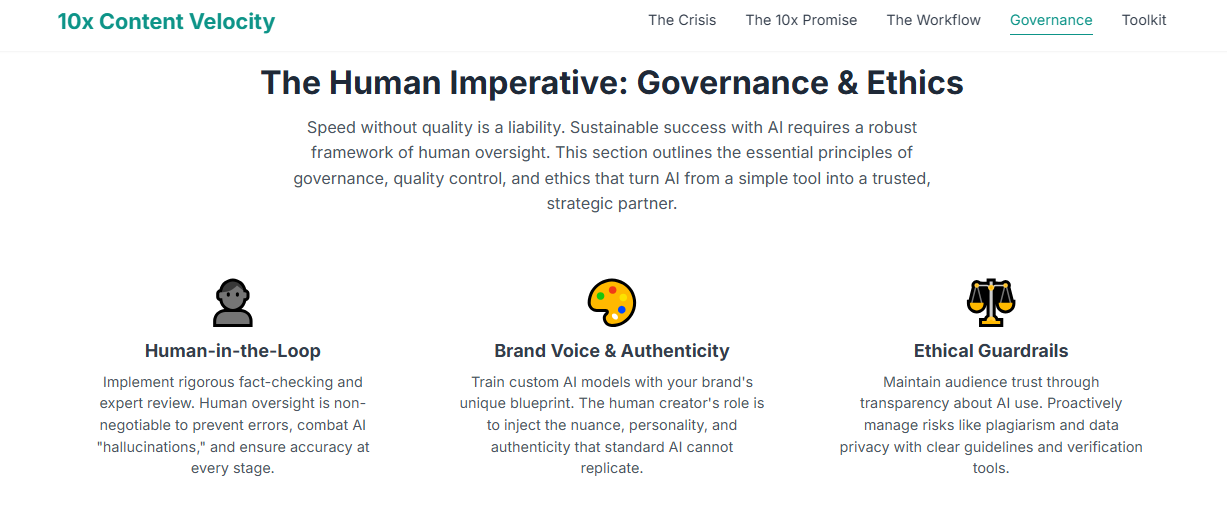
Maintaining Brand Voice and Authenticity
To overcome generic AI output, you must proactively train a custom AI voice model.
- Develop a “Brand Blueprint”: Create a comprehensive document that codifies your brand’s mission, values, voice, and tone.
- Provide Extensive Training Data: Feed the AI a large corpus of your best on-brand content (e.g., 15,000+ words for blog posts).
- Apply the Trained Model: When generating new content, specifically instruct the AI to use your custom-trained voice model to ensure every output is infused with your brand’s unique personality.
Navigating Ethical Considerations
The scale of AI introduces risks like misinformation and plagiarism that must be managed.
- Be Transparent: Disclose when content is AI-generated or significantly AI-assisted to maintain audience trust. 75% of businesses believe a lack of transparency could lead to customer churn.
- Avoid Plagiarism: Use advanced plagiarism checkers like the one offered by Grammarly, which can detect both direct plagiarism and AI-generated text.
- Ensure Fairness: Comply with data protection regulations and audit algorithms for bias to ensure they do not perpetuate discriminatory outcomes.
In the near future, access to powerful AI will be a commodity. The true competitive advantage will be the operational excellence of your human-AI collaboration—a system defined by rigorous quality control and unwavering ethical oversight.
Section 7: Conclusion: Your Roadmap to Becoming a 10x Content Creator
The journey out of the “Content Velocity Crisis” is about working smarter, not harder. It’s about re-engineering your workflow with AI as your strategic partner. The creator’s role evolves from a manual producer to a strategic director, orchestrating AI to handle the heavy lifting while focusing human expertise on strategy, refinement, and governance.
The 10x Creator’s Checklist
Ready to begin? Follow this actionable path to move from theory to implementation.
- ✅ Audit Your Time: Track the hours spent on your next content project to identify your unique bottlenecks.
- ✅ Build Your Brand Blueprint: Formally document your brand’s voice and tone. This is the most important asset for training your AI.
- ✅ Select Your Starter Stack: Choose one trusted tool for outlining, one for drafting, and one for image generation. Master this small stack first.
- ✅ Master the Prompt: The quality of your output depends on the quality of your input. Practice writing detailed, context-rich prompts.
- ✅ Implement the Human-in-the-Loop: Define your fact-checking and brand review process before you publish anything. This governance framework is non-negotiable.
- ✅ Start Small, Then Scale: Apply the full AI-augmented workflow to a single blog post. Refine your system, then scale it across your entire content strategy.
The rise of generative AI marks the beginning of a new era of human-computer collaboration. The future of content belongs not to the AI, but to the creators who master the art and science of collaborating with it. By embracing the role of the AI Orchestrator, you can break free from the velocity crisis and unlock an unprecedented level of productivity and creative potential.

